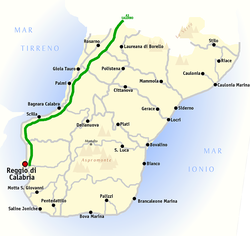Rosarno
| Rosarno | ||
|---|---|---|
| Comune | ||
| Comune di Rosarno | ||

View of Rosarno
|
||
|
||
 Map of the province of Reggio Calabria, with Rosarno located to the north between the coast and the A3 motorway (A3 depicted in green) |
||
| Location of Rosarno in Italy | ||
| Coordinates: 38°30′N 15°59′E / 38.500°N 15.983°E | ||
| Country | Italy | |
| Region | Calabria | |
| Province / Metropolitan city | Reggio Calabria (RC) | |
| Frazioni | Bosco, Crofala, Scattarreggia, Testa dell'Acqua, Zimbario | |
| Government | ||
| • Mayor | Giuseppe Idà | |
| Area | ||
| • Total | 39.5 km2 (15.3 sq mi) | |
| Elevation | 60 m (200 ft) | |
| Population (31 December 2015) | ||
| • Total | 14,841 | |
| • Density | 380/km2 (970/sq mi) | |
| Demonym(s) | Rosarnesi (also Rosarnisi) | |
| Time zone | CET (UTC+1) | |
| • Summer (DST) | CEST (UTC+2) | |
| Postal code | 89025 | |
| Dialing code | 0966 | |
| Patron saint | St. John the Baptist | |
| Saint day | Nativity of St. John the Baptist | |
| Website | Official website | |
Rosarno is a comune (municipality) in the Metropolitan City of Reggio Calabria in the Italian region of Calabria. It is about 70 kilometres (43 mi) southwest of Catanzaro and about 50 kilometres (31 mi) northeast of Reggio Calabria. Rosarno stands on a natural terrace cloaked in olive plantations and vineyards on the left bank of the river Mesima, overlooking the Gioia Tauro plain. The town is an important agricultural and commercial centre known for the production of citrus fruits, olive oil, and wines.
Within the borders of Rosarno is the site of the ancient city of Medma. Present day Rosarno appeared during the Byzantine Era, mentioned for the first time in a document in 1037. Ownership of Rosarno was greatly contested, due to its strategic importance in giving a hold over of the fertile Mesima valley and was controlled by various feudal lords, including the Ruffo and the Pignatelli families.
An earthquake in 1783 completely destroyed the town. In the plain surrounding Rosarno, the tremors caused huge landslides which blocked the course of rivers; the resulting marshes led to a malaria epidemic that killed more people than the earthquake itself. The town was quickly rebuilt and became a borough in 1816. The town plan is typified by large squares and straight, wide streets that cross each other perpendicularly. The remains of the old feudal castle are preserved, along with a 16th-century coastal tower, the clock tower, the beautiful church of St. John the Baptist, the small church of the Crucifix, and various noblemen's homes, many of which have magnificent marble doorways from the last century.
The situation has led to tensions between local inhabitants and the immigrants. In December 2008, a gunman entered a dilapidated factory where over a hundred farm workers were sleeping and shot two of them, seriously injuring a 21-year-old migrant from Côte d'Ivoire. The migrant workers took to the streets peacefully, marching through Rosarno to deliver a request to the prefectoral commissioner at the town hall for more humane treatment.
...
Wikipedia


